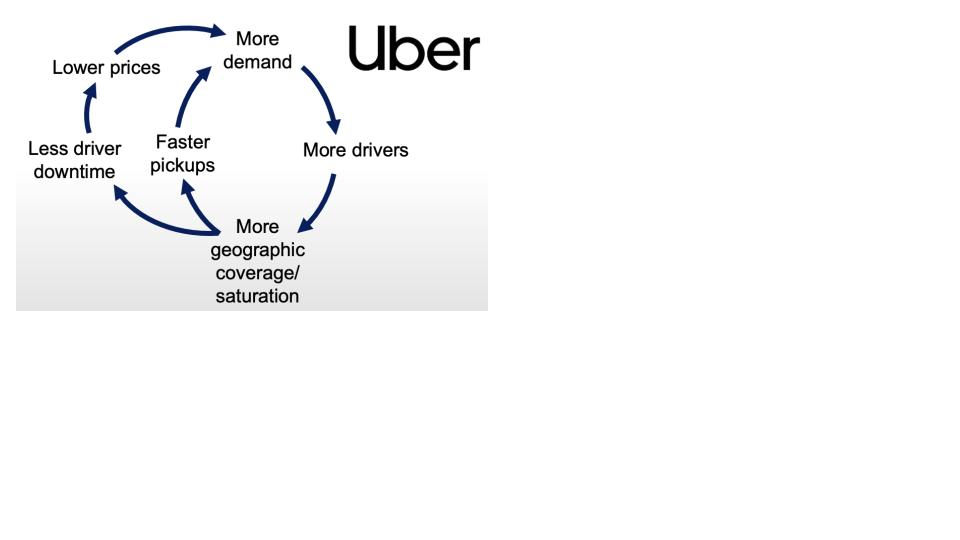
In business a virtuous cycle (also known as a virtuous circle) is a powerful concept used to describe a self-reinforcing cycle of positive outcomes that enhance each other, creating a continuous loop of improvement and success. There are many examples of virtuous cycles in business strategy including:
Network Effects - occurs when the value of a product or service increases as more people use it.
Brand Loyalty and Advocacy - when a company consistently delivers high-quality products or services, and customer service, it fosters loyalty among its customers.
Employee Engagement and Productivity - engaged and motivated employees are more productive, innovative and committed to the success of the organization.
Supply Chain Efficiency - a well-optimized supply chain can contribute to cost savings, faster delivery times and higher-quality products or services.
Innovation Ecosystems - by encouraging collaboration, knowledge sharing and experimentation among employees, partners and stakeholders companies can create virtuous cycles of creativity and advancement.
By understanding and leveraging these examples effectively, companies can create sustainable competitive advantages, leading to long-term growth.
What is the Flywheel Effect and how is it used in Business?
One of the more well known examples of a virtuous cycle is the Flywheel Effect. The Flywheel Effect was coined by Jim Collins in his book “Good to Great (Why Some Companies Make the Leap…And Others Don’t)” and describes how small, consistent actions can build momentum over time, leading to significant results. The central tenet of the concept is that your customers are your best salespeople. Its focus on creating momentum, building customer loyalty and delivering consistent value over time relies on three major components:
Attract - attract customers by building a solid reputation and creating good relationships with your target audience. Make useful content easy to discover.
Engage - generate awareness around your products and services, make it easy for prospective clients to engage with you via social media platforms, free trials and campaigns, and provide pertinent, easily accessible, information through the purchasing process.
Delight - design the product with ease-of-use in mind and embed self-help tools (documentation, knowledge bases, etc.), solicit customer feedback and make it actionable - thus delighting your users who will then recommend your product to their peers and leadership.
Success requires a long-term perspective and consistent effort. Incremental actions and improvements, over time build on each other, compounding the positive effects leading to increased growth and success.
Fundamental to delivering and managing this long-term, consistent, view is the importance of establishing goals and objectives, and measuring them over time (i.e. metrics such as Key Performance Indicators (KPIS), Objectives and Key Results (OKRs), etc.), Metrics such as these allow the organization to quickly and easily identify the incremental changes that are having positive effects, making it easier to achieve further improvements, resulting in the compounding effect mentioned earlier.
By focusing on these critical areas businesses are able to progress toward their goals in a measured and sustainable fashion, without having to rely on large-scale, risky initiatives or strategic “home runs”.
The Flywheel in Action
There are numerous case studies of how the Flywheel Effect has been used successfully to attract, engage and delight customers.. Amazon is one of the more well known examples, even though it may not be obvious to the casual observer the role that the Flywheel Effect plays.
Amazon is known for its exceptional customer service, which has played a critical role in its success. Several years ago Amazon CEO and founder, Jeff Bezos, adopted the Flywheel Effect and fine-tuned it for Amazon’s growth strategy.
Amazon was able to establish the self-perpetuating aspects of the Flywheel Effect by:
Excellent prices - leads to website traffic, exposing customer to
Prime membership - offers 2-day shipping highlighting Amazon’s
Customer service - user-friendly interface and seamless shopping experience leads to
More Sales - as customers make more purchases to utilize their Prime membership which exposes them to
Extra subscriptions - such as Amazon Music, etc.
Each step adds to the flywheel momentum creating a cyclical pattern of innovation, growth and long-term success. By continued re-investment their business and focus on incremental improvements Amazon has built one of the most valuable brands in the world with over 2B daily visitors.
Conclusion
The Flywheel Effect is a powerful example of a virtuous cycle that has been used by numerous organizations to guide their long-term business strategy. It focuses on turning your customers into your best salespeople by creating momentum, building customer loyalty and delivering consistent value over time through incremental improvements. This allows organizations to progress toward their goals in a sustainable fashion, without having to rely on large-scale, risky initiatives.
Developing a sound business strategy and execution plan is critical to any organization’s success. The Flywheel Effect, and other similar concepts, is an effective strategy framework that stresses the efficacy of accumulated incremental improvements or wins. The success of any business strategy, however, lies in its adoption by the organization, and its ability to track and measure the goals, objectives and metrics associated with that strategy. A platform such as StratifyPro provides the tools that help accelerate and ensure your strategy’s success.
Here is another example from Uber: Uber’s approach demonstrates that quicker pickups create more demand, attracting more drivers, prompting improved geographic coverage, reduced driver downtime, and decreased prices which creates more demand. This virtuous cycle continues to compound and is a good example of how superimposition of loops leads to the Flywheel Effect, as illustrated below:


Commenti